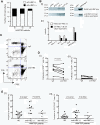Humoral immune response to HTLV-1 basic leucine zipper factor (HBZ) in HTLV-1-infected individuals
- PMID: 23405908
- PMCID: PMC3584941
- DOI: 10.1186/1742-4690-10-19
Humoral immune response to HTLV-1 basic leucine zipper factor (HBZ) in HTLV-1-infected individuals
Abstract
Background: Human T cell lymphotropic virus type 1 (HTLV-1) infection can lead to development of adult T cell leukemia/lymphoma (ATL) or HTLV-1-associated myelopathy/tropical spastic paraparesis (HAM/TSP) in a subset of infected subjects. HTLV-1 basic leucine zipper factor (HBZ) gene has a critical role in HTLV-1 infectivity and the development of ATL and HAM/TSP. However, little is known about the immune response against HBZ in HTLV-1-infected individuals. In this study, we examined antibody responses against HBZ in serum/plasma samples from 436 subjects including HTLV-1 seronegative donors, asymptomatic carriers (AC), ATL, and HAM/TSP patients using the luciferase immunoprecipitation system.
Results: Immunoreactivity against HBZ was detected in subsets of all HTLV-1-infected individuals but the test did not discriminate between AC, ATL and HAM/TSP. However, the frequency of detection of HBZ-specific antibodies in the serum of ATL patients with the chronic subtype was higher than in ATL patients with the lymphomatous subtype. Antibody responses against HBZ were also detected in cerebrospinal fluid of HAM/TSP patients with anti-HBZ in serum. Antibody responses against HBZ did not correlate with proviral load and HBZ mRNA expression in HAM/TSP patients, but the presence of an HBZ-specific response was associated with reduced CD4+ T cell activation in HAM/TSP patients. Moreover, HBZ-specific antibody inhibited lymphoproliferation in the PBMC of HAM/TSP patients.
Conclusions: This is the first report demonstrating humoral immune response against HBZ associated with HTLV-I infection. Thus, a humoral immune response against HBZ might play a role in HTLV-1 infection.
Figures




Similar articles
-
In vivo expression of the HBZ gene of HTLV-1 correlates with proviral load, inflammatory markers and disease severity in HTLV-1 associated myelopathy/tropical spastic paraparesis (HAM/TSP).Retrovirology. 2009 Feb 19;6:19. doi: 10.1186/1742-4690-6-19. Retrovirology. 2009. PMID: 19228429 Free PMC article.
-
Absolute quantification of HTLV-1 basic leucine zipper factor (HBZ) protein and its plasma antibody in HTLV-1 infected individuals with different clinical status.Retrovirology. 2016 Apr 27;13:29. doi: 10.1186/s12977-016-0263-z. Retrovirology. 2016. PMID: 27117327 Free PMC article.
-
In vivo expression of human T-lymphotropic virus type 1 basic leucine-zipper protein generates specific CD8+ and CD4+ T-lymphocyte responses that correlate with clinical outcome.J Infect Dis. 2011 Feb 15;203(4):529-36. doi: 10.1093/infdis/jiq078. Epub 2011 Jan 5. J Infect Dis. 2011. PMID: 21208912 Free PMC article.
-
Role of HTLV-1 Tax and HBZ in the Pathogenesis of HAM/TSP.Front Microbiol. 2017 Dec 21;8:2563. doi: 10.3389/fmicb.2017.02563. eCollection 2017. Front Microbiol. 2017. PMID: 29312243 Free PMC article. Review.
-
Tropical spastic paraparesis and HTLV-1 associated myelopathy: clinical, epidemiological, virological and therapeutic aspects.Rev Neurol (Paris). 2012 Mar;168(3):257-69. doi: 10.1016/j.neurol.2011.12.006. Epub 2012 Mar 7. Rev Neurol (Paris). 2012. PMID: 22405461 Review.
Cited by
-
Multifaceted functions and roles of HBZ in HTLV-1 pathogenesis.Retrovirology. 2016 Mar 15;13:16. doi: 10.1186/s12977-016-0249-x. Retrovirology. 2016. PMID: 26979059 Free PMC article. Review.
-
Preclinical assessment of an anti-HTLV-1 heterologous DNA/MVA vaccine protocol expressing a multiepitope HBZ protein.Virol J. 2023 Dec 19;20(1):304. doi: 10.1186/s12985-023-02264-z. Virol J. 2023. PMID: 38115107 Free PMC article.
-
Development and optimization of human T-cell leukemia virus-specific antibody-dependent cell-mediated cytotoxicity (ADCC) assay directed to the envelope protein.J Virol. 2025 May 20;99(5):e0226824. doi: 10.1128/jvi.02268-24. Epub 2025 Mar 28. J Virol. 2025. PMID: 40152593 Free PMC article.
-
Machine learning based characterization of high risk carriers of HTLV-1-associated myelopathy (HAM).Sci Rep. 2025 Jul 11;15(1):25111. doi: 10.1038/s41598-025-09635-2. Sci Rep. 2025. PMID: 40646051 Free PMC article.
-
Recent Updates on Viral Oncogenesis: Available Preventive and Therapeutic Entities.Mol Pharm. 2023 Aug 7;20(8):3698-3740. doi: 10.1021/acs.molpharmaceut.2c01080. Epub 2023 Jul 24. Mol Pharm. 2023. PMID: 37486263 Free PMC article. Review.
References
-
- Gessain A, Barin F, Vernant JC, Gout O, Maurs L, Calender A, de The G. Antibodies to human T-lymphotropic virus type-I in patients with tropical spastic paraparesis. Lancet. 1985;2:407–410. - PubMed
-
- Osame M, Usuku K, Izumo S, Ijichi N, Amitani H, Igata A, Matsumoto M, Tara M. HTLV-I associated myelopathy, a new clinical entity. Lancet. 1986;1:1031–1032. - PubMed
-
- Umehara F, Izumo S, Nakagawa M, Ronquillo AT, Takahashi K, Matsumuro K, Sato E, Osame M. Immunocytochemical analysis of the cellular infiltrate in the spinal cord lesions in HTLV-I-associated myelopathy. J Neuropathol Exp Neurol. 1993;52:424–430. doi: 10.1097/00005072-199307000-00010. - DOI - PubMed
Publication types
MeSH terms
Substances
Grants and funding
LinkOut - more resources
Full Text Sources
Other Literature Sources
Research Materials
Miscellaneous

